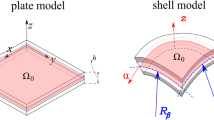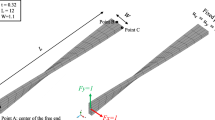Abstract
Recent precise, elastic numerical solutions to a surface flaw in a plate under remote tension and bending have been compared to arrive at a ‘best estimate’ of the stress-intensity-factor variation along the flaw border. The geometry of the semielliptical surface flaw examined had a depth to length ratio of 0.25 (a/2c=0.25) and 25- and 75-percent relative crack depths (a/t=0.25, 0.75). The analysis methods used to determine the solutions included: Schwarz alternating technique, finite-element method and boundary-integral-equation method. The derived best-estimate curve for the stress-intensity factor is believed within 3 percent of the actual value along the crack front. The best-estimate curve compared well with scarce experimental data (±10 percent). The difference between the best-estimate curve and experiment is thought largely due to differences in geometry and Poisson's ratio.
Similar content being viewed by others
Abbreviations
- a :
-
crack depth
- a eff :
-
effective crack depth due to plasticity
- c :
-
1/2 crack length on plate surface
- c eff :
-
effective 1/2 crack length due to plasticity
- E :
-
Young's modulus
- F m :
-
magnification factor for remote tension loading, defined in eq (4)
- F b :
-
magnification factor for remote bending loading, defined in eq (8)
- K I :
-
Mode I stress-intensity factor
- K I EM :
-
Mode I stress-intensity factor for buried elliptical crack under remote bending loading, defined in eq (1)
- K I EB :
-
Mode I stress-intensity factor for buried elliptical crack under remote bending loading, defined in eq (6)
- M m :
-
engineering magnification factor for remote tension loading, defined in eq (10)
- M b :
-
engineering magnification factor for remote bending loading, defined in eq (12)
- r :
-
radius measured from the crack tip normal to crack front
- r y :
-
radius of plastic zone
- t :
-
plate thickness
- x, y, z :
-
plate coordinate system, defined in Fig. 3
- ν:
-
Poisson's ratio
- ϕ:
-
elliptical angle, defined in Fig. 2
- Φ:
-
complete elliptical integral of second kind, defined in eq (2)
- Φ′:
-
complete elliptical integral of first kind, defined in eq (7)
- σ:
-
remote stress
- σ:
-
remote bending stress
- σ m :
-
remote tensile stress
- σ y :
-
yield stress
- H :
-
half length of plate
- W :
-
half width of plate
References
Irwin, G.R., “Crack Extension Force for a Part-Through Crack in a Plate,”J. of Applied Mech.,29,Trans. ASME, Series E,651–654 (Dec.1962).
Swedlow, J.L., ed., The Surface Crack: Physical Problems and Computational Solutions, ASME, New York (1972).
Newman, J.C., Jr., “A Review and Assessment of Stress Intensity Factors for Surface Cracks,” NASA Technical Memorandum 78805 (Nov. 1978).
Hulbert, L.E., “Benchmark Problems for Three-Dimensional Fracutre Analysis,”Int. J. Fract.,13,87–91 (1977).
Smith, F.W. and Sorensen, D.R., “The Semielliptical Surface Crack—A Solution by the Alternating Method,” TR No. 4, Department of Mechanical Engineering, Colorado State University, NASA Grant NGL-06-002-063 (Aug. 1973).
Kobayashi, A.S., “Crack Opening Displacement in a Surface Flawed Plate Subjected to Tension or Plate Bending,”Proceedings of the Sec. Intern. Conf. on Mech. Behavior of Matls., Federation of Materials Societies, Aug. 16–20, 1976, Boston, MA, 1073–1077, Amer. Soc. for Met., Dearborn, MI (1976).
Raju, I.S. and Newman, J.C., Jr., “Improved Stress-Intensity Factors for Semi-Elliptical Surface Cracks in Finite-Thickness Plates,” NASA TMX-72825 (Aug. 1977).
Newman, J.C., Jr. and Raju, I.S., “Analyses of Surface Cracks in Finite Plates Under Tension or Bending Loads,” NASA TP-1578 (Dec. 1979).
Tracey, D.M., “Finite Element for Three-Dimensional Elastic Crack Analysis,” Nuclear Engrg and Des.,26 (1974).
Atluri, S.N. and Kathiresan, K., “Stress Analysis of Typical Flaws in Aerospace Structural Components Using Three-Dimensional Hybrid Displacement Finite Element Methods,” AIAA Paper 78-513, Proc. AIAA-ASME 19th SDM Conf., Bethesda, MD, 340–350 (Aug. 1978).
Atluri, S.N. andKathiresan, K., “Three-Dimensional Analysis of Surface Flaws in Thick Walled Reactor Pressure Vessels Using Displacement-Hybrid finite Element Methods,”Nuclear Engrg and Des.,51 (2),163–176 (1979).
Kathiresan, K., “Analysis of Three-Dimensional Fracture Problems by a Displacement-Hybrid Finite Element Method,” PhD Thesis, Georgia Institute of Technology (Sept. 1976).
McGowan, J.J. and Raymund, M., “Stress Intensity Factor Solutions for Surface Flaws in Finite Thickness Plates Under Arbitrary Loading,” WCAP-9318, Westinghouse Electric Corporation (April 1978).
Parks, D.M., “A Stiffness Derivative Finite Element Technique for Determination of Crack Tip Stress Intensity Factors,”Int. J. of Fract.,10,487–502 (1974).
Heliot, J., Labbens, R. andPellissier-Tanon, A., “Benchmark Problem No. I-Semi-Elliptical Surface Crack — Results of Computation, March 1979,”Creusot Loire, Framatome, Paris, France. See also Int. J. Fract,15 (6),R197-R202 (Dec.1979).
Green, A.E. andSneddon, I.N., “The Distribution of Stress in the Neighborhood of a Flat Elliptical Crack in an Elastic Solid,”Proceedings of the Cambridge Philosophical Society,46,159–164 (1950).
Merkel, J.G., “A Review of Some of the Existing Stress Intensity Factor Solutions for Part-Through Surface Crack,” Oak Ridge National Laboratory, ORNL-TM-3983 (Jan. 1973).
Shah, R.C. and Kobayashi, A.S., “On the Surface Flaw Problem,” The Surface Crack — Physical Problems and Computational Solutions, J.L. Swedlow, Ed., ASME, 79–124 (1972).
Smith, C.W., “Use of Three-Dimensional Photoelasticity and Progress in Related Areas,”Experimental Techniques in Fracture Mechanics,2,A.S. Kobayashi, Ed., Soc. for Exp. Stress Anal.,3–58 (1975).
Packman, P.F., “The Role of Interferometry in Fracture Studies,”Experimental Techniques in Fracture Mechanics,2,A.S. Kobayashi, Ed., SESA,59–87 (1975).
Hodulak, L., Kordisch, H., Kunzelmann, S. and Sommer, E., “On the Growth of Part-Through Cracks,” Fracture Mechanics, C.W. Smith, Ed., ASTM STP-677, 399–410 (1979).
McGowan, J.J., “A Photoelastic Investigation of the Effect of Crack Front Curvature on the Stress Intensity Factor Distribution in a Single Edge Notch Specimen,” Proceedings of the Tenth Southeastern Conference on Theoretical and Applied Mechanics, J.E. Stoneking, Ed. (Apr. 1980).
Fourney, M.E., “Experimental Determination of the Effect of Crack Front Curvature in an ASTM Tension Specimen,” Proceedings of the Fourth Brazillian Cong. of Mech. Eng., 13–26 (1977).
Smith, F.W., “The Elastic Analysis of the Part-Circular Surface Flaw Problem by the Alternating Method,” The Surface Crack: Physical Problems and Computational Solutions, J.L. Swedlow, Ed., ASME, 125–152 (1972).
Smith, C.W. andJolles, M., “Stress Intensities in Deep Surface Flaws in Plates Under Mode I Loading,”Developments in Theoretical and Applied Mechanics, R.P. McNitt, Ed., Virginia Polytechnic Institute and State University, Blacksburg, VA, 151–160 (Apr.1976).
Schroedl, M.A. and Smith, C.W., “Local Stresses Near Deep Surface Flaws Under Cylindrical Bending Fields,” Progress in Flaw Growth and Fracture Toughness Testing, ASTM, STP 536, 45–63 (Oct. 1973).
Author information
Consortia
Rights and permissions
About this article
Cite this article
Benchmark Editorial Committee of the SESA Fracture Committee. A critical evaluation of numerical solutions to the ‘Benchmark’ surface-flaw problem. Experimental Mechanics 20, 253–264 (1980). https://doi.org/10.1007/BF02328409
Received:
Issue Date:
DOI: https://doi.org/10.1007/BF02328409




